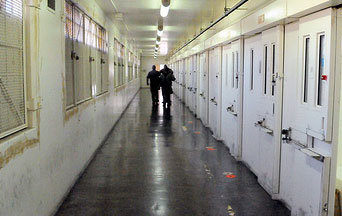Why lethal injection is not the way to go

Workers walk through the halls where executions take place.
Dennis Mcguire pleaded guilty to raping and murdering a pregnant newlywed named Joy Stewart in 1989. Mcguire was sentenced with the death penalty, and on January 16, 2015 he laid strapped to a bed, ready for the injection to end his life. For 26 minutes, it didn’t.
He thrashed and struggled against the pain for 10 minutes, until finally succumbing to the two drugs administered, midazolam and hydromorphone.
Mcguire’s death set a record for the longest execution in Ohio’s history, but unfortunately it is among many botched lethal injection attempts since its inception in 1982, including an Oklahoma execution that lasted 43 agonizing minutes.
Capital punishment has always been the government’s way of effacing criminals they consider to be incorrigible, or beyond reform.
The first time the death penalty was used was in Texas to execute 40-year-old Charles Brooks for murdering Fort Worth mechanic David Gregory.
Until 2010, the process consisted of a three-drug combination that used an anesthetic, a paralytic drug and a drug that stopped the heart, but lately due to vast shortages in supply and disapproval of international community, states have been taking shortcuts and using risky or untested combinations of drugs in lieu of the older methods.
European manufacturers of the drugs introduced a sort of embargo and refused to export if the drugs were being used for lethal injection. The states scrambled to find alternative combinations of drugs and the effects have been detrimental.
The number of cases in which complications have occurred has risen steadily since the embargo, and national trust in lethal injection and the death penalty itself has waned.
Now, the supply of the drugs runs dry for most states and the search for an alternative remains.
Questions have been raised over the past year concerning how humane lethal injection is, considering many instances where prisoners have waited agonizingly long to die when the drugs don’t do what they’re supposed to, or don’t do it fast enough.
The public attention brings back the avid debate of many and widespread disapproval.
There is a wide range of drugs that states have been testing out on unwitting death row inmates, but some of the more common and controversial drugs are called midazolam and pentobarbital, and they cause paralyzation and stopping of the heart, respectively.
Midazolam is especially unpredictable and has been the cause of flukes in a large number of lethal injection cases.
It isn’t possible to ensure a peaceful transition into unconsciousness, or to know how much pain the inmates are experiencing.
The only thing that is clear is that it certainly isn’t painless and a change should be made.
The problem with injecting a concoction of chemicals with a range of results into a prisoner is that there is no way to predict across the board how each person will react to the drug, and if it will have the intended effect.
The drugs that were standard issue prior to the shortage at least had relatively homogeneous effects, but now with the unpredictability of the drugs states are using, it’s a roll of the dice.
From an international standpoint, the death penalty is abhorred, but even nationally, disapproval runs high.
Only 32 states continue to use the death penalty, and within those states, many citizens protest and actively oppose the punishment.
Heated debates in Supreme Court bring the problem to the national table and pose the question of the effectivity of the method, as well as a wider question pertaining to the morality of the death penalty in general.
The two sides of the debate oppose and support lethal injection on the grounds of personal morals, qualms against the effectivity of the method and more.
Proponents of lethal injection argue the point that it is the fault of the opponents who actively lobbied to discontinue the use of the more stable and predictable drugs, which caused the subsequent frenzy of states using unpredictable drugs and giving lethal injection a bad reputation.
Additionally, the perspective of those who agree with the punishment is of a more karmic nature in that they believe that an action such as murder should have an equal repercussion.
On the other hand, the opponents believe that the death penalty is unconstitutional, no matter how painless it is, so even if lethal injection were 100 percent effective in 100 percent of cases, the fact that it is killing makes it cruel and unusual punishment.
The opponents also believe that killing someone for murder is hypocritical. If the punishment is identical to the crime, the punishment itself must be the same crime.
The death penalty has always been controversial, for a number of reasons, but when putting a criminal to death is synonymous with torture, the issue deepens exponentially. Isn’t the process supposed to be streamlined? Isn’t America better than that?
The way that these states are willing to try out untested and dangerous drugs on prisoners shows a blatant disregard for their humanity.
Despite whatever terrible crimes they may have committed, all citizens have the same right to fair treatment, and cruel and unusual punishment is not fair or right.
Regardless of one’s stance on the death penalty itself, all should agree on the fact that the unpredictable and unsafe lethal injection should not be allowed under the law even for the most wicked of criminals, because the law should be objective, and all citizens equal underneath it.

Senior Sadie Modica has been on the A-Blast staff for three years. In addition to her responsibilities as Co-Editor-in-Chief, Sadie is an IB Diploma candidate...









